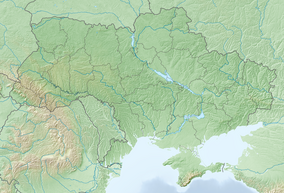
Summary
Gorgany Nature Reserve (Ukrainian: Заповідник «Ґорґани») is a strict nature reserve (a 'zapovidnyk') of Ukraine that covers a part of the Gorgany mountain range of the Outer Eastern Carpatians in southwest Ukraine. The reserve is 46% old-growth forest, one of the last and largest such stands in Europe. The reserve was originally created in 1996 to protect relic stands of Stone pine trees (Pinus cembra). The reserve is administratively in the Nadvirna District of Ivano-Frankivsk Oblast.[1]
| Gorgany Nature Reserve | |
|---|---|
| Ukrainian: Заповідник «Ґорґани» | |
 Mountains in Winter, Gorgany Nature Reserve | |
 Location of Park | |
| Location | Nadvirna District, Ivano-Frankivsk Oblast |
| Coordinates | 48°27′09″N 24°14′00″E / 48.45250°N 24.23333°E |
| Area | 5,344 hectares (13,205 acres; 53 km2; 21 sq mi) |
| Established | 1996 |
| Governing body | Ministry of Ecology and Natural Resources (Ukraine) |
| Website | http://gorgany.if.ua/uk.html |
Topography edit
The Gorgany range is mostly strongly-layered sedimentary rock (a type called flysch), that fractures into debris fields known locally as 'gorgan'.[1] The full vertical range of the central Carpatians are represented, with altitudes in the park ranging from 710 to 1754 meters above sea level.[2] The range runs from northwest to southeast, on Cretaceous and Quaternary conglomerates, sandstones, clay and marls. There are 30 mountain streams in the park, forming a dense network that feed into the Bystrytsia River. The steep landscape, formed in the Wurzburg glaciation, is covered with coniferous forests.
Climate and ecoregion edit
The climate of Gorgany is Humid continental climate, warm summer (Köppen climate classification (Dfb)). This climate is characterized by large seasonal temperature differentials and a warm summer (at least four months averaging over 10 °C (50 °F), but no month averaging over 22 °C (72 °F).[3][4] Average temperature in January is −7.6 °C (18.3 °F) and in July is 16.4 °C (61.5 °F). Average annual precipitation is 853–1,007 millimetres (33.6–39.6 in).[2] Average annual humidity is 78%.
Flora and fauna edit
76% of the territory is stable, natural forest that has grown on its own and demonstrates the sustainability of the site through the complete forest cycle. 46% of the total area is virgin (old-growth) forest, totalling over 2,110 hectares (8.1 sq mi).[5]
The dominant trees in the old-growth stands are spruce and pine. The relic pines (European, ordinary, and mountain pine), decay to produce the soil that supports the more productive successor fir and beech forests. The lower elevations are mixed deciduous and coniferous.[2] The most numerous non-tree plants are the herbaceous perennials, with relatively fewer shrubs (cranberries, heather, blueberries, etc.)[6] The main altitude zones are:
- Stream valley - mixed forest.
- Moderate and cool zone (770-1200 meters asl) - spruce forest
- Moderately cold thermal zone (1200-1600 meters asl) - pure fir and cedar-spruce forest
- Sub-alpine zone (about 1600 meters asl) - pine shrubs, and rocks covered with moss and lichen[6]
Further down on the lower stream terraces are speckled alders (Alnus incana), with grass cover featuring white butterbur (Petasites albus), meadowsweet (Filipendula ulmaria), marsh horsetail (Equisetum palustre), marsh-marigold (Caltha palustris), and narrow-leaved bittercress (Cardamine impatiens).
Scientists have mapped the reserve into 17 different characteristic forest types, the diversity due to altitude zoning, soil differences, micro-climate differences, and other factors that make the Gorgany Reserve a valuable reference for natural Carpathian ecosystems.[6]
Public use edit
As a strict nature reserve, Gorgany's primary purpose is protection of nature and scientific study. Public access is limited: mass recreation and construction of facilities is prohibited as are hunting and fishing.[1]
See also edit
- Lists of Nature Preserves of Ukraine (class Ia protected areas)
- National Parks of Ukraine (class II protected areas)
References edit
- ^ a b c "Gorgany Nature Reserve" (in Ukrainian). Official Park Site. Retrieved June 16, 2019.
- ^ a b c "Geology of Gorgany Nature Reserve" (in Ukrainian). Official Park Site. Retrieved June 16, 2019.
- ^ Kottek, M.; Grieser, J.; Beck, C.; Rudolf, B.; Rubel, F. (2006). "World Map of Koppen-Geiger Climate Classification Updated" (PDF). Gebrüder Borntraeger 2006. Retrieved September 14, 2019.
- ^ "Dataset - Koppen climate classifications". World Bank. Retrieved September 14, 2019.
- ^ "Virgin Forests of Gorgany Nature Reserve" (in Ukrainian). Official Park Site. Retrieved June 16, 2019.
- ^ a b c "Flora of Gorgany Nature Reserve" (in Ukrainian). Official Park Site. Retrieved June 16, 2019.
External links edit
- Media related to Gorgany Nature Reserve at Wikimedia Commons
- Boundaries of Gorgany Nature Reserve on OpenStreetMap.org


